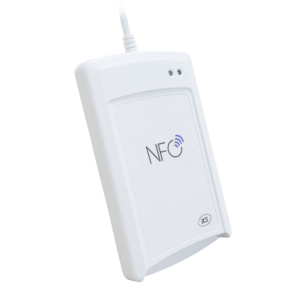Table of Contents
ToggleIntroduction
RFID card readers, often referred to as Radio Frequency Identification devices, are pivotal in modern identification technology. These devices streamline the process of identifying and acquiring data from objects equipped with RFID tags. Notably, they execute this task without any need for human intervention. Their efficiency extends to recognizing objects in motion and handling multiple RFID tags simultaneously. This ensures operations are conducted both swiftly and conveniently. To cater to various needs, RFID card readers come in different formats, primarily categorized into fixed and handheld devices. The handheld variants further diversify into different frequency types, including low, high, and ultra-high frequencies.

Types of RFID Card Readers
Fixed RFID Card Readers
Fixed RFID card readers are stationary devices designed for permanent installation at specific locations. These readers are commonly used in areas requiring constant monitoring, such as entry points in buildings, inventory management in warehouses, and assembly lines in manufacturing facilities. They are highly reliable for tracking the movement of goods and people, providing real-time data and enhancing security and efficiency. The fixed nature of these readers ensures continuous operation without the need for frequent adjustments or relocations.
Handheld RFID Card Readers
Handheld RFID card readers offer the advantage of mobility, making them suitable for applications requiring flexibility and on-the-go usage. These portable devices are ideal for environments where fixed readers may not be practical or possible. They are extensively used in retail for inventory checks, in logistics for tracking shipments, and in field operations for asset management. Handheld RFID readers can be easily carried around, enabling users to scan RFID tags in various locations and conditions, thereby improving operational versatility and efficiency.
Low-Frequency RFID Readers
Low-frequency (LF) RFID readers operate at frequencies around 125 kHz. They are known for their ability to read tags through materials such as water, metal, and organic tissues, making them suitable for specific applications like animal tracking and access control. LF RFID readers have a shorter read range, typically a few centimeters to a meter, which provides added security as only tags in close proximity can be read. This frequency range is less susceptible to interference from other electronic devices, ensuring reliable performance even in challenging environments.
High-Frequency RFID Readers
High-frequency (HF) RFID readers function at around 13.56 MHz and are widely adopted for applications like contactless payment systems, smart cards, and library book tracking. These readers have a moderate read range, reaching up to about 1 meter. HF RFID readers are favored for their balance between range and data transfer speed, making them suitable for environments where efficient yet secure data exchange is required. The popularity of HF RFID technology is driven by its versatility and the availability of affordable tags and readers.
Ultra-High-Frequency RFID Readers
Ultra-high-frequency (UHF) RFID readers operate between 300 MHz and 3 GHz, providing a significantly longer read range, often several meters. These readers are ideal for applications that need to cover extensive areas such as large-scale asset tracking, supply chain management, and retail inventory systems. UHF RFID readers are capable of reading multiple tags simultaneously, which is particularly useful in high-volume environments. However, they may be more affected by environmental factors such as water and metal, requiring careful planning and setup to ensure optimal performance.
Conclusion
RFID card readers, with their diverse types and frequency ranges, offer robust solutions for a variety of identification and tracking needs. Whether fixed or handheld, these devices aid in efficiently managing and monitoring assets and access. By leveraging different frequency technologies, RFID readers can be tailored to specific applications, ensuring optimal performance and convenience. As technology advances, the capabilities and applications of RFID card readers will continue to expand, driving greater efficiency and security in numerous fields.
